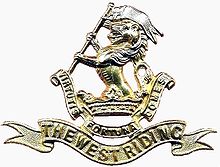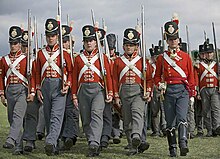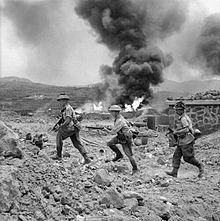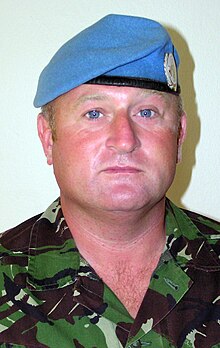Duke of Wellington's Regiment
The Duke of Wellington's Regiment (“West Riding”) was an English infantry regiment with a long history. The line regiment of the British Army , which had existed under changing names since 1702, had been part of the King's Division since 1968. The Duke of Wellington's Regiment (DWR) was active until 2006 when it was merged with other regiments of the King's Division to form the Yorkshire Regiment . The DWR, which was stationed in the Battlesbury Barracks, Warminster / Wiltshire , had various nicknames during its existence: "The Dukes", "The Havercake Lads", "The Pattern", "The Immortals", "The Pigs" , "The Old Seventy-Sixth", "The Old Seven and Sixpennies" or "The Duke of Boot's". The motto of the regiment was Virtutis fortuna comes = Fortune favors the brave ("Luck is with the brave").
history
Lineup, formation and name history
In 1702, George Hastings, 8th Earl of Huntingdon , was authorized to set up an infantry regiment around the British city of Gloucester . As was customary at the time, the regiment was named after its Colonel Huntingdon. From 1751 it was called the 33rd Regiment of Foot . In 1782 it was renamed the 33rd (1st West Yorkshire West Riding) Regiment of Foot . In 1852 the 1st Duke of Wellington died and in the following year, by decree of Queen Victoria, the 33rd Regiment was given the nickname The Duke of Wellington's Regiment . In 1881, as part of the Childers reforms , the 33rd Regiment was combined in Halifax with the 76th Foot Regiment, which served for a long time in India . From these two regiments the 1st and 2nd Battalion of the Duke of Wellington's Regiment were formed, plus a militia battalion. In 1948 the two battalions were merged into a new 1st battalion. On June 6, 2006 there was a merger with the Prince of Wales's Regiment of Yorkshire and the Green Howards , which formed the 3rd Battalion of the New Yorkshire Regiment .
Mission history
DWR battalions have served in most of the land wars in the Kingdom of England since its inception. So in the Spanish and Austrian War of Succession , the American War of Independence , in various campaigns in India and Africa , the Napoleonic Wars , the Boer War and in most of the major land battles of the First World War . The DWR fought in 1914 in the Battle of Mons , in 1916 in the Battle of the Somme , in 1917 in the Third Battle of Flanders (Battle of Passchendaele / “Battle of the Mud”) and in the Battle of Cambrai . 7,870 members of the DWR were killed during the fighting. Outside the European theater of war, the regiment was used in the Third Anglo-Afghan War in 1919 . During the Second World War , the DWR was part of the British Expeditionary Force in France in 1940 and reared up at the Battle of Dunkirk . In addition, units of the regiment fought from 1942 to 1944 in North Africa , Italy and France . Well-known missions were the landing in Normandy in 1944 and the Burma campaign against Japanese aggressors until 1945 .
In 1952, the Duke of Wellington's Regiment gained fame in the Battle of the Hook during the Korean War when it managed to hold its positions for an extended period of time in the face of overwhelming Chinese forces. The unit was awarded for this. In 1956 the PWR in the former British colony of Cyprus broke the EOKA resistance in the Troodos Mountains during Operation Golden Rain . During the Cold War , the PWR had served with the BAOR in Germany since 1961 and, in the event of a V, was to be used in the tank battle in the North German Plain . The PWR equipped with the Humber FV1611 APC was stationed in Osnabrück from 1964 to 1968 . In 1966/67 the Humber Pig was replaced by the FV 432 . The regiment took part in numerous NATO exercises in Germany, Denmark and Norway in the following years .
In 1986 the regiment bivouacked at the Höltigbaum training area and then took part in the LANDJUT corpse combat exercise Bold Guard . The 1st Battalion from Salisbury under Lieutenant Colonel Johnny Walker was one of the 15,000 strong British troops (11,000 of them UKMF - UK Mobile Force) and had the order to take up position near Itzehoe with its Fox armored personnel carrier .
From 1971 to 1997 the Duke of Wellington's Regiment was used intermittently in the Ulster Province in the Northern Ireland conflict. The DWR was one of the first associations to cross the border from Kuwait to Iraq in the Second Gulf War in 2003 . Nine soldiers of the regiment were awarded the Victoria Cross . Corporal Wayne Mills, 1st Battalion / DWR, was the first to receive the Conspicuous Gallantry Cross in 1994 for his services to the United Nations in Bosnia .
Relationship with Arthur Wellesley 1st Duke of Wellington
Since 1793, Arthur Wellesley , who later became the Duke of Wellington, commanded the 33rd Regiment. He took part with him in campaigns in the Netherlands and India until 1803 . In 1806 he became a colonel and held this post until 1813. Under his command, the regiment fought in the Battle of Waterloo in 1815 . On June 18, 1853, the anniversary of this historic battle and since this unit had a special relationship with the Duke of Wellington, the 33rd Regiment was awarded the title of "Duke of Wellington's" Regiment.
structure
- 1st Battalion (1st Battalion)
- 2nd Battalion (2nd Battalion)
- 1/6 and 1/7 battalions (1 / 6th and 1 / 7th battalions)
- 2/6 and 2/7 battalions (2 / 6th and 2 / 7th battalions)
- 8th Battalion (8th Battalion)
- 58th Anti-Tank Regiment (58th (Duke of Wellingtons) Anti-Tank Regiment)
- 43rd Battalion (43rd AA (5th Duke of Wellingtons) Battalion)
Commanders
- 1702–1703 Colonel George Hastings
- 1703-1705 Colonel Henry Leigh
- 1705–1705 Colonel Robert Duncanson (February 12 to May 8, 1705)
- 1705-1717 Field Marshal M. George Wade
- 1717–1730 Lieutenant-General Henry Hawley
- 1730–1739 Lieutenant-General Robert Dalzell
- 1739–1753 Lieutenant-General John Johnson
- 33rd Foot Regiment (from 1751)
- 1753–1760 Major-General Lord Charles Hay
- 1760–1766 Field Marshal John Griffin, 4th Baron Howard de Walden
- 1766–1805 General Charles Cornwallis, 1st Marquess Cornwallis
- 33rd (1st Yorkshire West Riding) Foot Regiment (from 1782)
- 1806–1812 Field Marshal Arthur Wellesley, 1st Duke of Wellington
- 1813-1830 General John Coape Sherbrooke
- 1830–1831 General Lord Charles Somerset
- 1831–1845 General Sir Charles Wale
- 1845–1847 Lieutenant General Sir Henry Sheehy Keating
- 1847–1855 General Henry D'Oyly
- 33rd (The Duke of Wellington's) Foot Regiment (from 1853)
- 1855–1863 Field Marshal Sir Charles Yorke
- 1863–1881 General William Nelson Hutchinson
- The Duke of Wellington's (West Riding Regiment) (from 1881), together with 76th Foot Regiment
- 1881–1895 General William Nelson Hutchinson (1st Battalion)
- 1881–1886 General Frederick Darley George CB. (2nd Battalion)
- 1895-1897 Major-General George Elphinstone Erskine
- 1897–1909 General Hugh Rowlands
- 1909–1934 Lieutenant General Sir Herbert Eversley Belfield
- The Duke of Wellington's Regiment (“West Riding”) (from 1921)
- 1934–1938 Brigadier-General Percy Alexander Turner
- 1938–1947 Colonel Charles James Pickering
- 1947–1957 General Sir Alexander Frank Philip Christison
- 1957–1965 Major-General Kenneth Godfrey Exham
- 1965–1975 General Sir Robert Napier Hubert Campbell Bray
- 1975–1982 Major-General Donald Edward Isles
- 1982–1990 General Sir Charles Richard Huxtable
- 1990–1999 Brigadier General William Richard Mundell
- 1999-2006 Major-General Sir Evelyn John Webb-Carter
Web links
- The Duke of Wellington's Regiment - Regimental Association
- The Duke of Wellington's Regiment in WW I (engl.)
- Yorkshire Regiment, DWR Association
- Unit History: Duke of Wellington's (West Riding Regiment), Forces War Record, (Eng.)
- History of Duke of Wellington's Regiment. British Army Units (engl.)
Notes and individual references
- ^ Organizational unit of the British Army in Northern England
- ↑ The dukes
- ↑ the immortals
- ↑ the pigs
- ↑ Medals of the Regiments: The Duke of Wellington's (West Riding Regiment)
- ^ Korea and The Hook, 1953 at www.dwr.org
- ↑ the British version of the M-113 -MTW
- ^ Chronicle of the PzGrenBtl 173. In: panzergrenadierbrigade17.de. Accessed on May 28, 2017 : “The British also took part with around 15,000 soldiers. Of these, around 650 soldiers from the British Infantry Battalion 1st Bataillon / The Duke of Wellington's Regiment had already arrived in Hamburg a week before the start of the exercise. They pitched their tents at the Höltigbaum training area . Since the PzGrenBtl 173 was in charge of looking after the British, they came up with an extensive 'animation program'. "
- ↑ probably referring to the Fuchs armored personnel carrier
- ^ British association preparing for maneuvers. To the “Kühnen Wacht” in Hamburg. Hamburger Abendblatt, September 16, 1986
- ^ Exercise Bold Guard, Schleswig-Holstein, September 1986. 1st Battalion the Royal Hampshire Regiment and 1st Battalion the Duke of Wellington's Own Regiment, September 24, 1986
- ↑ Anthony H. Cordesman: The Iraq War: Strategy, Tactics, and Military Lessons , Center for Strategic & International Studies, US, 2003, p 40, ISBN 978-0-89206-432-8 .
- ^ Corporal Wayne Mills, 1st Battalion The Duke of Wellingtons Regiment, in Action Near Gorazde, Bosnia 29th April 1994, for which he was awarded the Conspicuous Gallantry Cross By David Rowlands










